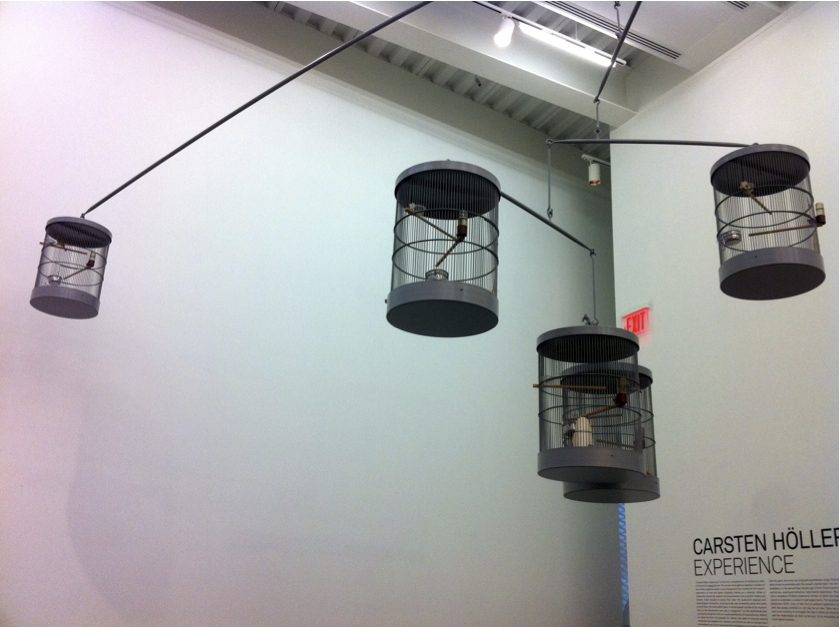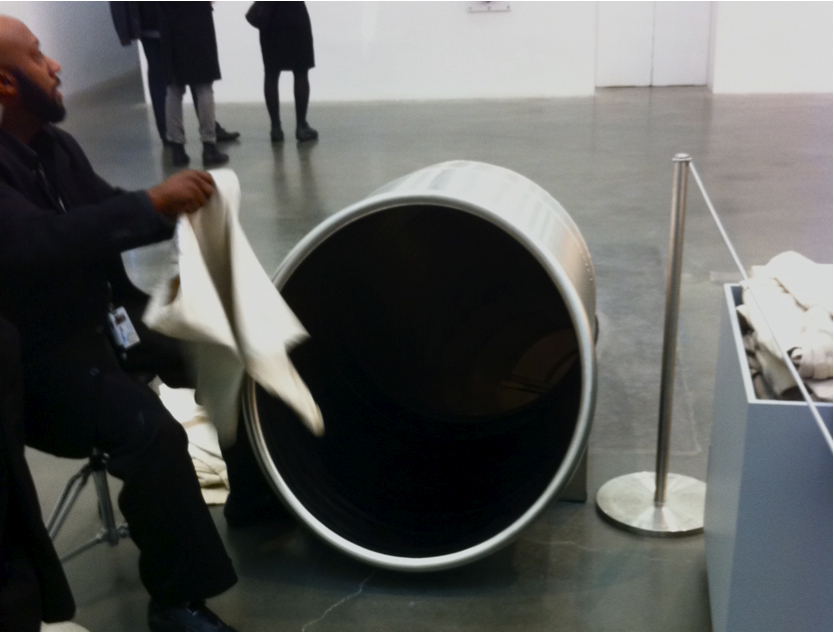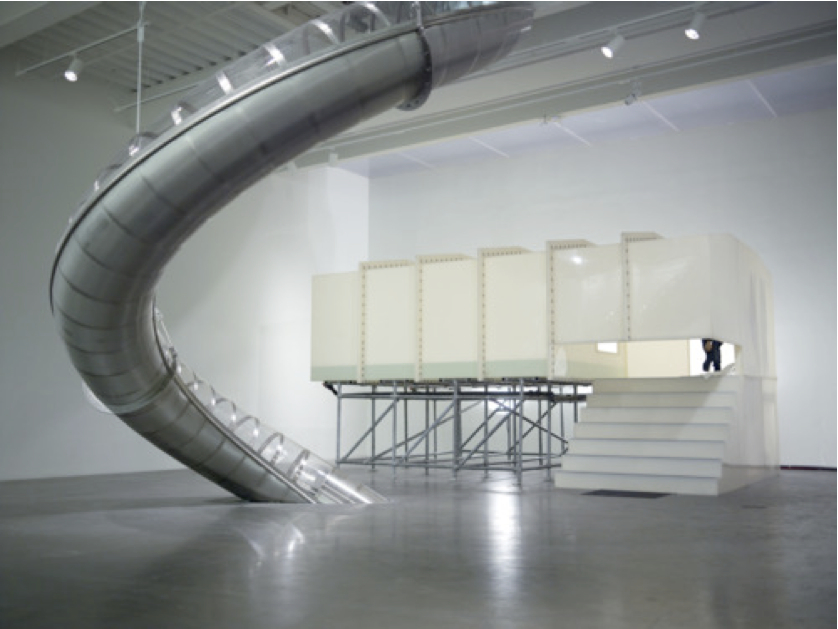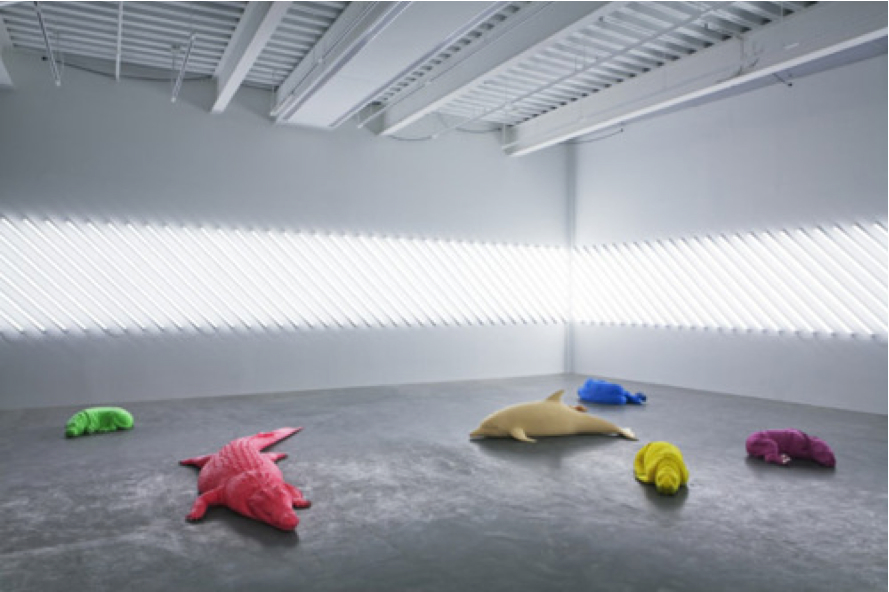Carsten Höller: Experience
by Emma S. Hazen
LAB REPORT: Carsten Höller: Experience
ABSTRACT
The New Museum is a laboratory and its visitors are the test subjects with the current show, Carsten Höller: Experience. In this article, I present my current research on the subject, including discussion with the exhibition's curator, Massimiliano Gioni. The museum will be conducting research onsite until January 15, 2012, and is still looking for willing participants for ongoing experiments.
INTRODUCTION
With a racing heartbeat, sweaty palms, and a clenched throat, I was so nauseous I almost lost my place in line to run to the bathroom while waiting to enter the circular tube, Untitled, Höller's slide instillation on the fourth floor of the New Museum. As I waited, I felt claustrophobically isolated, caught in a metal cage like the birds in the piece, Singing Canaries Mobile that precariously loomed overhead. The solemn chirping of the live yellow birds mimicked the anxious yet excited chatter among the procession of visitors. After waiting a long half an hour as my fear of heights continued to build, I finally reached the front of the line. I held my breath, and let go. Almost immediately, my anxiousness escaped me. I screamed with delight somewhere between the fourth and third floor. But before I could even look out into the galleries below, I had already plummeted through the New Museum's floors, and was being helped out of the slide by a gallery attendant. I caught my breath and a wave of adrenaline swept through me. Suddenly, I realized my surroundings--instantly I was struck by intense, seizure-inducing flashes. My head filled with shock, adrenaline, and blinding light. I felt like Alice--as if I had fallen down past the second floor gallery, all the way into the rabbit hole.
METHODS
Carsten Höller: Experience is visceral. It is not an exhibition about what you see, but what you feel. Between the slide, the sensory deprivation tank, the upside-down goggles, and the mysterious white pills the visitor is offered to swallow with water from an office cooler, Experience is a participatory exhibition. The museum functions as a scientifically-inspired, hyperreal playground blurring the boundaries between the visitor and the art.
Like test mice running though a maze, Höller carefully orchestrates the participant's movement through the exhibition. With Mirrored Carousel, the visitor's pace is slowed down to a lethargic cyclical crawl on a carousel of suspended metal chairs, minimally decorated with fluorescent lights and mirrors. In contrast, on the same floor Untitled accelerates the visitor's velocity, propelling the viewer through previously uncharted aerial gallery space.
Due to the participatory nature of the show, waiting in line becomes a part of the experience--the museum is transformed into a space of socialization. While waiting for my chance to slide, I bonded with the women in front of me over our mutual fear of heights. To kill time while waiting for Psycho Tank, the sensory deprivation pool, the man next to me let me borrow his upside-down goggles, which he had signed a $1,500 waiver for. After emerging from the pool, a family of onlooking tourists inquired about my escapade. I even witnessed a man photographing random strangers as they shot down the tubular slide. Experience asks you to participate fully with your environment, including the people standing next to you.
RESULTS
The physicality of the show is highly captivating; as the viewer, you are unable to disconnect from the pieces. You are forced to directly engage with yourself, the art, and your social as well as physical surroundings. The art becomes inseparable from your individual experience, challenging your perception of reality.
The hyperreality of the exhibition even feels surreal at times. For example, Höller presents us with elements of nature--life-size statues of exotic animals, live canaries and fish, and giant mushroom sculptures--for us to examine in detail. Even though these animals and fungi are very apart of reality, these facets of nature normally only exist in our memory or fantasy, yet suddenly they are surreally standing before us at Experience.
Yet, the visitor is not the only test-subject, Höller equally deconstructs and examines the the museum as an institution. The New Museum's transformation into a kinesthetic science laboratory environment was quite refreshing. Carsten's inventive use of the gallery space and close attention to the viewer's movement through the show was exciting and new, toying at the boundaries--social, psychical, and psychological--between the museum, the viewer, and the art.
DISCUSSION
For greater depth into my research, I phoned Massimiliano Gioni, the associate director and director of exhibitions at the New Museum, to discuss Carsten Höller: Experience.
emmä: Höller commented to the New York Times, "What I’m doing is certainly not science, but maybe it’s not art, either; it’s something in between, a third thing." How did you go about curating a show that falls between art and science?
Massimiliano: I like the comment that we don't know if its art or something else, but it's not a show in between art and science. I think every good artwork hopefully redefines the definition of itself and of art in general. I'm interested in the artist and I'm interested in the fact that [Carsten] helped us redefine what art is. I don't know if its science or something else, but that's where things get interesting.
e: So you didn't think about this exhibition differently than other shows?
M: No, I didn't. Well, I know that Carsten's work is all about questioning what art is, and that's what I'm interested in, and he comes from a scientific background, so I guess he does do science to make art, but I think it's a stretch to say, you know, that science is a bigger deal...[Laughs]
e: For the exhibition, you had to punch holes in the floors of the New Museum to install the slide. How do you think about space when curating a show?
M: We wanted a slide, and it turned out to be more practical to drill the holes than to do it elsewhere. I think [Carsten] made it really special because it was the first time one of his slides went through a building. It was one of the most exciting elements of the exhibition. And [the slide is] a challenge, but every good artwork is supposed to challenge; sometimes it's a physical one, sometimes it's a conceptual one.
e: How did you think about the viewer's movement through the exhibition?
M: The verticality of the museum is one of its features, so I thought [the slide] was a brilliant way to address that. We liked the way the artist is presenting an artwork but also addressing the physicality of the space itself.
e: I've read you like art that doesn't make sense or you don't understand completely. Can art, like Höller's, that is based in the individual experience, ever be understood objectively?
M: I think every art[work] doesn't make total sense, I think that's why we’re in this business. [Art] is one of the only fields that not making sense is encouraged.
e: Is the meaning of Experience only subjective?
M: That's what the show is about. It's about testing the viewer and it's also about the viewer testing the museum. One thing that is quite exciting about the show and exiting about art in general is [Carsten] helped us readdress what the museum is supposed to be and seeing how the public uses it. Not just because [the exhibitions] are like self-experiments, but also because people are cheering in the museum. They go downstairs where the people get spit out by the slide and they are shouting for joy and clapping. There is an interesting metamorphous that the artist imposes on the institution.
And in general, if you look at the history of art and also contemporary art, you could write an alternative history of what people are allowed to do in the museum. When MoMA started, they were very hands-on, the public could touch the objects. Through the 60s with performance, the whole movement was interested in questioning the institution by bringing in live individuals and making them do things, and the public was there to see [the performance] happening. I think it's due to shock value that museums redefine themselves.
And to a certain extent, this exhibition does that, because the people go through the museum without a respect that you usually pay to artworks--it’s a very participatory experience. And that is still quite a huge violation in the way museums are conceived today where the barrier between the viewer and the object is still there. [The museum] is meant to be a space of contemplation. Carsten Höller: Experience sort of violates all of these expectations about the museum. Everybody's loud, everybody's moving around, everybody's touching the objects. I think that's an exciting change, maybe just a temporary change, but it’s something when the institution has to rethink boundaries. Some boundaries are physical like drilling a hole, and others are more conceptual. And I think that is what ultimately what art is about, trying to redefine the boundaries of the place we look at art and how we look at it.
e: When I went to the show, I thought it was really amazing that I started talking to all of the strangers in line with me about the exhibition.
M: It's also like the museum is as social space. Carsten uses, in a way the grammar of entertainment and the public approaches the museum in a completely different and even liberating. That was a different kind of message to the museum, which is another unusual element in this exhibition. We are seeing lots of people coming who are not the art public, so I don't know what they are seeing, are they seeing an art show or something else? And I think that's something Carsten's work is very interested in.
e: Yeah, definitely. What was your experience like in the sensory deprivation pool?
M: I haven't tried it, actually! But I have to do it before they close.
e: I was imagining you floating around there after hours.
M: No, no, we do the slide a lot, but I haven't done the sensory deprivation tank yet.
e: Besides an experience, what do you hope the visitor takes away from Carsten Höller: Experience?
M: I think this show proposes the idea that you go to a museum not just to see but to also to see yourself. The museum becomes a space where the boundaries of the viewer are questioned and the boundaries between the institution and the viewer are questioned. I hope that the most valuable experience of the show is questioning these boundaries.
e: What's next for the New Museum?
M: One element that is very important in Carsten's work is the idea of the test site. The museum is a place where we try to think out the game we’re in, but the test has to end at some point. That may be the dark side, but on the other hand, I hope the viewers can bring the experience with them wherever they go.
On the practical point of view, the next show is going to be very different. It’s a group exhibition of young artists for our second triennial, and we're trying to bring to New York what New York doesn't usually see. This show is going to bring exposure and recognition to a lot of artists from very different countries such as Italy and South Africa, who are not usually shown.
e: I'm looking forward to it. Any favorite shows up right now in New York?
M: Well right now I'm going up to MoMA, and I don't know if its tonight or in the next few days, but they're reinstalling a piece by Rirkrit Tiravanija. I'm particularly curious about that, and also Maurizio Cattelan who is up at the Guggenheim right now. Rirkrit, Maurizio, and Carsten all grew up making work together and showing together in the 90s. Each in their different way made the point of pushing the boundaries of what is allowed in the museum--Rikirt making food in the museum and Maurizio Cattelan questioning the authority of the museum and looking at the artist as somebody who can get away with everything because he's expected to. Maurizio Cattelan's work is more about the ethics of the museum, and the way that we sometimes allow the artist to perform even illegal gestures just because the museum is a sort of the territory outside of the normal ethical boundaries. And you have Carsten who expands the boundaries in terms of entertainment and participation. I think it's quite exciting that in three different museums in New York you have three different examples of artists who all belong to the same generation and all examined and tested what is possible within the institution of the museum itself.
CONCLUSION
As I floated around in lazy circles inside the sensory deprivation pool, I began to reflect upon what I was doing on the Bowery, alone, naked, and in complete supported suspension in lukewarm salty water. Though I found some pieces in the show highly artful, was my experience in this pool art or just fun? Had I been lured to the New Museum by the prospect of a unique experience over the prospect of a unique art exhibition?
After a few swirls around Psycho Tank, I felt underwhelmed and ready to get dressed. The experience within the sensory deprivation pool, though distinct, was not as enlightening as I had hoped. Yet, as I showered and emerged from Psycho Tank with dripping wet tangled hair, I was smiling. Even though I felt some pieces in the show overemphasized the experience, eclipsing the essence of the art, I wore my messy hair as a proud signifier for Carsten Höller--physical evidence that I was indeed, experienced.






